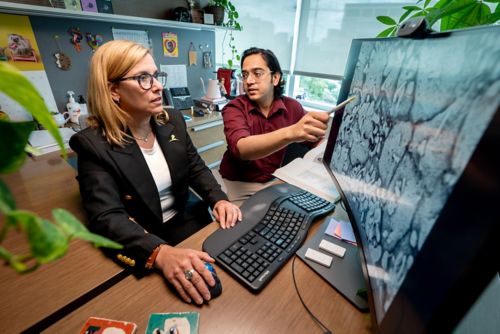St. Jude Family of Websites
Explore our cutting edge research, world-class patient care, career opportunities and more.
St. Jude Children's Research Hospital Home

- Fundraising
St. Jude Family of Websites
Explore our cutting edge research, world-class patient care, career opportunities and more.
St. Jude Children's Research Hospital Home

- Fundraising
The long and the short of the cell antenna

After noticing curiously short primary cilia in cells with inhibited SHH signaling, corresponding author Stacey Ogden, PhD and first author Shariq Ansari, PhD, took on the task of unraveling the elegant interconnectivity found within the primary cilium.
For many, a key part of growing up was adjusting antennas to better receive radio or television signals. Bending, twisting, lengthening, shortening, moving, all to tune the signal for better reception of whatever channel was on the screen. The digitalization of media has made this process largely redundant, but these aren’t the only antennas that exist. In nature, insects and other organisms use antennae to sense their surroundings. Within our bodies, cells also use a type of antenna to send and receive important information.
The primary cilium, which protrudes off most cells like a little hair, reaches into the surrounding environment, detecting signals that help the cell react appropriately. While cell membranes are dotted with environment-sensing proteins, the primary cilium provides a specialized and highly organized hub of communication which concentrates certain types of signaling receptors. The primary cilium enhances the cell’s ability to detect and respond to specific signals effectively.
Just like every household needed a volunteer to adjust the television antenna when the signal reception dropped, cells must also maintain the integrity of the primary cilium for optimal signaling. When cells mismanage their primary cilium, many pathways are disrupted, contributing to anything from respiratory issues to neurological disorders.
Sonic Hedgehog relies on a strong cilium

The primary cilium, shown here using fluorescently labeled proteins, functions as a key hub of communication between cells by sending and receiving signals.
The Sonic Hedgehog (SHH) pathway, which guides the development of cells during tissue formation, relies heavily on the primary cilium for the organization and regulation of the interactions necessary for reliable signaling. Stacey Ogden, PhD, St. Jude Department of Cell & Molecular Biology, has kept herself tuned to primary cilia for much of her independent career as she and her team pursue a more complete understanding of cell-to-cell communication, particularly that involving the SHH pathway.
Considering the role the SHH pathway plays in embryonic development and cell differentiation, it makes sense that SHH would have a large stake in maintaining the integrity and length of the primary cilium. In a recent publication in the Journal of Cell Biology, corresponding author Ogden investigated how SHH influenced primary cilium length. “If the primary cilia aren’t functioning well, you don’t get good SHH signaling,” she said. “We found that the SHH pathway has evolved a way to link signaling activity to stability of the primary cilium to ensure that the primary cilium stays happy so signals can be communicated.”
When first author Shariq Ansari, PhD, inhibited a key player in the SHH pathway, the protein phospholipase 2, the researchers noticed something strange was going on. “This started as a serendipity project,” Ansari said. “We were looking at a special cell line for studying primary cilium architecture, and during a lab meeting, Stacey stopped me and said, ‘Oh, those cilia are shorter. Something’s happening there.’” This observation began Ansari’s journey down a hedgehog hole as he tracked the link between SHH signaling and cilium length.

Given the limited space within the primary cilium, the pathway linking SHH signaling with cilium length is one of economic necessity. It begins with activation of Smoothened (SMO), which drives production of arachidonic acid. Arachidonic acid is the signal for SMO to enter the cilium as part of the SHH signaling pathway but is also broken down into prostaglandin E2. Release of prostaglandin E2 out of the cell allows it to bind to EP4 on the surface of the cilium, triggering the production of cAMP, the abundance of which regulates cilium length. Modified from an original graphic by Shariq Ansari, PhD.
Mapping out the complete pathway
An established roadmap for cilium regulation indicated that the Gαs-coupled ciliary G-protein coupled receptor E-type prostanoid receptor 4 (EP4) should be the first port-of-call for investigating the short cilia. EP4 increases the concentration of the messenger molecule cyclic adenosine monophosphate (cAMP), which, in turn, helps maintain cilium length when in abundance. The researchers wanted to identify the steps in SHH signaling that also affected EP4 signaling, which, when disrupted, caused shorter cilia.
“We used pharmacological and genetic approaches to take out different steps in what we thought was the signal relay. And each time, anywhere that we affected the ability of SHH to engage in crosstalk with EP4, we would get short cilia,” Ogden stressed. “We hit it with drugs. We took out genes. We were getting shorter cilia every time.”
Through the process of elimination, the researchers finally revealed the complete picture of how SHH helps maintain ciliary length. It all starts with activating the SHH pathway component Smoothened (SMO). This signaling protein, which cycles into and out of the primary cilium, activates phospholipase 2. Phospholipase 2 activation leads to the production of a vital messenger molecule, arachidonic acid. Arachidonic acid is the signal that enhances SMO entry into the primary cilium but is also broken down into the hormone prostaglandin E2, which the cell pumps outside of its cell membrane. This chemical then binds to EP4 on the surface of the primary cilium, activating it and initiating the production of cAMP.
Each step along this pathway had to be individually tested, an arduous task, especially considering the researchers had to maintain biologically correct protein levels. “It was a lot of fine-tuning, a lot of painstaking groundwork to figure out these conditions,” Ansari said. “But once we had it standardized, it worked beautifully.”
A small but mighty cellular component
A fascinating paradox of the primary cilium is its lack of real estate; the cell needs to be economical with how its space is utilized. For this reason, the cross-linking of pathways is a critical feature. Ogden hopes to continue investigating the cross-linked nature within primary cilia, especially the intriguing connection between SMO activation and arachidonic acid. “When the SHH pathway is on, it links SMO ciliary translocation to a signal crosstalk circuit that promotes ciliary fitness,” Ogden explained. “So anytime it’s on and SMO’s going into the primary cilium, that arachidonic acid, which is the thing that helps it get in the primary cilium, is also feeding this signal that maintains ciliary length.”
As the lab’s investigations continue, Ogden is more than happy to stay tuned on the small, but mighty cellular component. “For so many years, people thought primary cilia were functionless organelles that weren't doing anything. It turns out it is a major regulatory path for all these different signaling pathways,” she said. “It's another observation about how important this little antenna is.”






